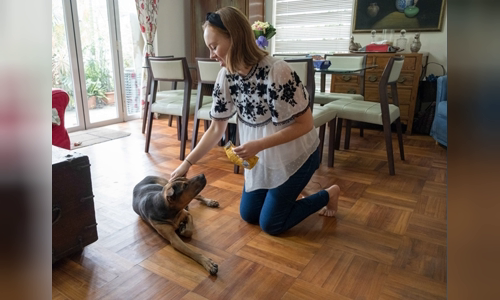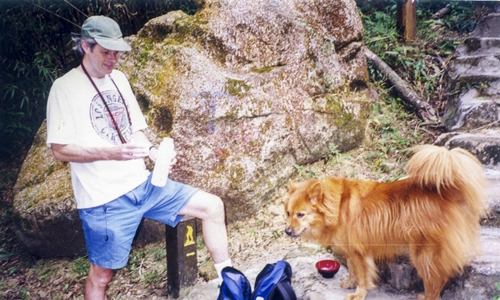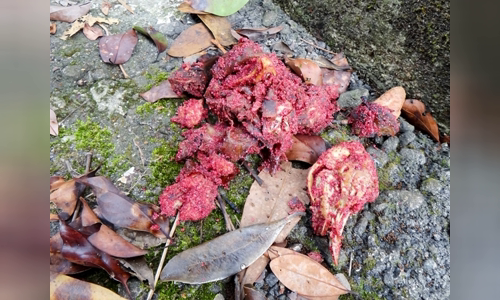What Sarah James remembers most when her pet dog Max was beaten in 2007 was that she shed black tears.
The dog vomited and trembled as the veterinarian hurriedly used activated carbon, hoping to prevent the poison from entering the blood. A little bit of coal shot Max's eyes.

Hundreds of dogs were beaten with no solution in Hong Kong Photo: SCMP
At that time, James was a student at Cang Dao high school in Mid-Levels (San San area). When she heard Max's parents dying on the phone, she immediately took him to the vet. "His body was cold and shaking, I really didn't know what to do," James said.
James, now 27, works as a manager at a 5-star hotel in Kowloon. In the living room at the house in Sai Kung, she stroked her pet dog Holly.
Like Max, Holly was also beaten. "He vomited and had diarrhea all over the house. He was panting and sweating and it was like crazy," James said. But luckily Holly was saved in time and survived.
Both Max and Holly were beaten within a few months on Bowen Road, an empty route linking some of Hong Kong's richest neighborhoods. The dogs ate poisoned food, drooled, vomited, convulsions and, if not promptly rescued, suffered organ failure and death.
Hundreds of dog slaughterings have occurred on and around this route since 1989. In the 1990s, the issue did not receive much attention until March 4, 1997, when Whiskey, the Governor's dog Hong Kong Chris Patten, poisoned on Bowen Road. At that time, the world was focusing on the British about to hand over Hong Kong to China on July 1, 1997, so this case was reported not only by the local media but also by the international media. The most recent case was on January 7, 2017, two dogs ate poisoned chicken.
The only person who said that he witnessed the culprit was the lawyer Jonathan Midgley. In 1995, he was taking two dogs for a walk early in the morning when he discovered they had run off somewhere. "I turned around and saw a man in a blue overalls," Midgley said.
"He is Chinese, 1.7 m tall, about 35-40 years old, round face, has very thin hair but not to the level of bald. He exudes a strange look," Midgley said.

Jonathan Midgley and pet dog Ruth in the 1990s Photo: SCMP
Midgley said that the man who gave pet dog Ruth something from a pink plastic bag. I immediately suspected and asked him "what are you doing?". He said: "I love animals and I love birds. I come here in the morning and feed them."
The lawyer tried to extend the conversation with the man but after a few minutes, he said he had to leave. About a minute later, Ruth began to vomit and tremble. The dog was poisoned with chicken but survived.
Midgley reported this meeting in 1995 but the police were rather indifferent. When the media noticed the poisoning of Patten the dog two years later, the story of Midgley came to light.
But now, three decades after the pet was first beaten on Bowen Street, officials have yet to find the culprit. In 2002, on the concrete wall on Bowen Street, a mysterious painting appeared: a red spray paint with the words "not yet, not that there will be no vengeance, but there is no cause and effect".
Students at Hong Kong University's Criminology Center studied the case. The police ask for advice from Helena Striwing, the Swedish animal rights expert and an adviser to the Swedish police. Striwing, dubbed the "pet detective," was tasked with building the killer's profile using the methods used to track down serial killers.
"I think it's a lonely person who hates people. He wants to make people suffer as much as possible," Striwing said.
Unknown motives of the culprit. There are rumors that this is a dog hate or racist (many people living on Bowen Road are not Chinese but wealthy foreigners). Perpetrators may also be angry because pet owners do not control animals or clean them when they go to the toilet.

Dog baits were discovered in Hong Kong in September 2014 Photo: SPCA
To prevent the attacks, the Association for the Prevention of Cruelty to Animals (SPCA) has been regularly patrolling Bowen Road and surrounding areas since 2007. When the attacks were frequent, inspectors check the road three times a day, 30 minutes to an hour each time.
They tried to find and discover what could be baits, but Berry Ng Yuen-fun, chief inspector of SPCA, said their activities were largely for prevention and awareness. "We distributed leaflets and mostly talked to dog owners, suggesting dogs to wear muzzles. We have no authority to stop anyone, if we find her she will call the police."
"She was initially exposed, like pieces of flesh with a peculiar characteristic, with purple-pink particles. However, in some recent times, she was not on the path but hidden in the grass." he said.
Although no one doubts Midgley's account, it is hard to believe that there was only a single perpetrator and he avoided being spotted for 30 years. "This problem has lasted so long that it is hard to believe that only one person will act," Lloyd Kenda, head of Valley Veterinary Center, said.
However, Midgley blamed herself for not taking drastic action when meeting the man in blue overalls. "But what to do now. The person said he used to feed the dogs and birds. You are suspicious but you know what to do? How to keep him?" He said.
"But if I had acted differently or more drastically, I might have stopped the person I suspected was the main culprit, and probably the only culprit," Midgley added.



 DebbieHolland
DebbieHolland







